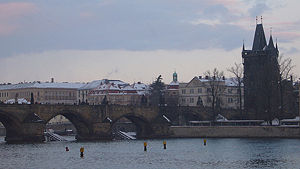Charles Bridge
Charles Bridge (in Czech: Karlův most) was once the only link between the two halves of Prague and is one of the city's most recognisable monuments. It spans the river Vltava and is the main route connecting Prague's Old Town to St. Vitus' Cathedral. Commissioned by Charles IV to replace the Judith Bridge, it was designed by the court architect Peter Parler. Known as the the Prague or the Stone Bridge until the late nineteenth century, in 1870 it was officially named after its patron.
Occupying a central and strategic location in the heart of Prague, linking the seat of government to the commercial centres of the Old and New Towns, the Charles Bridge has been the site of many significant events in Czech history. Among them: the last battle of the Thirty Years' War in 1648, the defeat of the Prussians in 1744, and the front line between the revolutionaries and reactionaries in 1848.
Charles Bridge has previously allowed traffic and once had a tram line, however since 1950 the bridge is open to foot traffic only. The statues that line the bridge are copies of the sandstone originals, which may be seen in the Lapidárium. Today it is one of the major tourist attractions of the city of Prague, and during the day is crowded with visitors and buskers.
The first stone bridge that crossed the river Vltava was the Judith Bridge, named after Judith of Thuringia, wife of the then monarch Vladislav II. It symbolised the ennoblement of the Přemyslid dynasty after the crowning of Vladislav II by Frederick of Barbarossa. The Judith Bridge was destroyed in 1342, a significant demise to chroniclers of the day.[1]
According to legend, the foundation stone of the bridge was laid by Charles IV upon advice of astrologers to formally open the bridge on a palindromic date and time: 5:31 a.m. July 9, 1357 (the palindromic sequence being: 1357-9-7-531). During commemorative events celebrating the foundation of the bridge, the stone is again blessed at 5.31am every July 9th.
The left bank of the bridge joined with the remains of the Judith Bridge, which still remain today, and on the right bank was built the Old Town Bridge Gate (Staroměstská mostecká věž). The Bridge Gate's prominence and centrality meant that as well as a primary defensive structure, it was sculpted to make a major visual statement regarding the career of Charles IV.[2]

